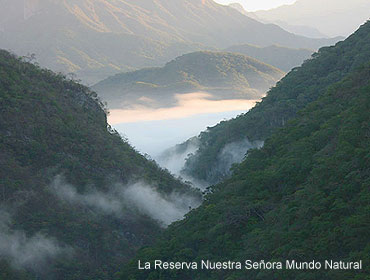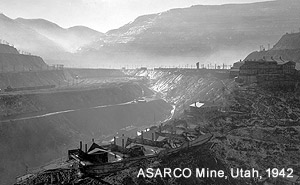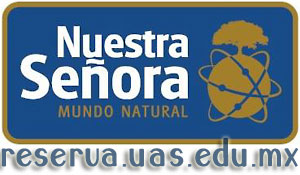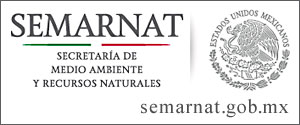Ecotourism and zip lines in the heart of Sinaloa!
North El Quelite | La Noria | Meseta de Cacaxtla and Barras de Piaxtla
Las Labradas Petroglyphs | San Ignacio | Lake El Salto | Cosala
Reserva Nuestra Senora Mundo Natural | Durango
South Concordia | Copala | El Rosario | Playa el Caimanero | Teacapan
Islands near Mazatlan Stone Island | Deer and Goat Islands | Bird Island


Located just eight miles to the east of Cosala -- and under two miles from the Durango State border -- this ecological paradise encompasses over 13,000 acres of unspoiled tropical deciduous forest and associated micro-ecosystems.
Bisected by the El Habal river, Reserva Nuestra Señora Mundo Natural is home to a breathtaking variety of plants and animals including a profusion of bird species including the endangered Green Macaw.
The reserve is a mecca for wildlife watching and nature photography, and everyone from hardcore archaeology enthusiasts to casual day trippers marvel at the ancient petroglyphs that are found along the El Habal river within the sanctuary.
The reserve contains numerous mapped hiking trails and observation platforms.
Video about Reserva Nuestra Señora Mundo Natural
The eco reserve is administered by Universidad Autónoma de Sinaloa (UAS), which has reached out creatively to make Reserva Nuestra Señora Mundo Natural as scientifically relevant and user-friendly as any ecological reserve in Mexico.
The administration of Reserva Nuestra Señora Mundo Natural is under the overall direction of Dr. Jose Alfredo Leal Orduño, with MC. Marco Antonio González Bernal serving as Chief Biologist.
In addition to facilities and programs designed to support scientific study, the reserve has opened its gates to all manner of day trippers and has created delightful lodging options for visitors who want to spend more than part of a day within it.
General admission to Reserva Nuestra Señora Mundo Natural is an insanely inexpensive 30 pesos (less than 2.5 USD), with a guided tour option adding all of 50 pesos to that.
Reserva Nuestra Señora Mundo Natural offers overnight camping (about 7.5 USD per night); hostel bunks (at about 16 USD per night); rooms in their hotel (different packages, but generally between 20 - 40 USD per night per person); private cabins (at about 75 USD per night per person) and two multi-bedroom cottages: one that sleeps a maximum of eight for about 200 USD per night and another that sleeps a maximum of ten for about 250 USD per night.
Beyond great sleeping accommodations, there are two special man-made treats at the reserve: an advanced telescope and a hyper-advanced zip line!
The telescope at Reserva Nuestra Señora Mundo Natural can rock your astronomical vacation house.
The telescope is, obviously, just for visitors who stay the night, and can only make observations when weather permits.
A private visit to the observatory costs just 150 pesos (about 12 USD) and includes a introduction to the astronomical project at the reserve and live observation through the telescope if the sky is cooperating.
If the sky cooperates, you are in the strikingly silent Sierra Marde foothills observing the birth of the universe.
Does that sound OK?
Are you a zip line freak? Let the zip lines at Reserva Nuestra Señora Mundo Natural blow your mind.
The zip line at Reserva Nuestra Señora Mundo Natural can be enjoyed on day trips pretty much whatever the weather is -- and it is a big rush!
Priced at just 400 pesos (under 35 USD), Reserva Nuestra Señora Mundo Natural has a zip line the is the second longest -- 750 meters! -- and the second highest (over 1200 feet!) zip line in Mexico.
There are four zip lines at the reserve: a short 45 meter training lina and two spectacular 180 and 500 meter lines, as well as the 750 meter monster.
Video of the zip lines at Reserva Nuestra Señora Mundo Natural
Do I need hiking gear to visit Reserva Nuestra Señora Mundo Natural?
You don't need any special equipment for your visit to the reserve, but UAS recommends that you...
• Wear hiking boots or, at least, sneakers
• Wear denim or other rugged-fabric pants
• Wear a long sleeve shirt
• Bring a hat of some type
• Bring a handkerchief
• Bring a field book or other notebook and writing instrument
• Bring an attitude that reflects a respect for nature
mazatlantoday.net adds: carrying insect repellent probably isn't a bad idea, nor is the idea of carrying sunscreen -- whatever the season.
Reserva Nuestra Señora Mundo Natural
Mazatlan Day Trip Directions


GPS N24°40'55" W106°60'88"
Reserve Hours 10am to 5pm Daily
Reserve Telephone 667 796 0516
Office in Cosala Rosales y Gpe. Victoria
Office Hours 9am - 1pm and 4pm - 7pm
Office Telephone 696 108 4032
Website reserva.uas.edu.mx
A brief history of how Reserva Nuestra Señora
Mundo Natural became one of Sinaloa States' eco-reserve gems!

ASARCO was -- and is -- known for the large scale of its' operations, and the mines near Cosala were highly productive and profitable for nearly two decades. But by the mid 1960s the mines to the east of Cosala had been substantially depleted.
ASARCO was in financial distress and the combination of falling mine production and financial pressures led to shutdown of the entire ASARCO / Cosala mining operation in 1965.
In 1968 ownership of over 13,000 acres that were part of the former ASARCO land holdings in Sinaloa were transferred to the Universidad Autónoma de Sinaloa (UAS) for the purpose of creating an eco reserve where the flora and fauna of southeast Sinaloa could be studied, and where education could take place within an immersive teaching environment.
In the mid 2000s UAS was approached by Scorpio Mining Corporation, a Canadian-based international mining company with extensive operations in Mexico.
Scorpio Mining believed -- and has subsequently proved -- that while the areas' mines may have been "depleted" by 1960s standards, cleaner high-tech 21st century extraction methods made the mines east of Cosala, once again, a very viable northwestern Mexico mining location.
Today, Scorpio Mining operates a sophisticated mechanized high technology underground mining operation that feeds a 1,600 ton per day processing facility that has been permitted for over twice that capacity, in anticipation of new veins of Sinaloa ore being mined near Cosala.
The current yield of the mines is substantial: in the first quarter of 2014 Scorpio reported that mines east of Cosala produced nearly 300,000 ounces of silver; close to 3 million pounds of zinc; roughly 1.2 million pounds of lead and over 300,000 pounds of copper.




